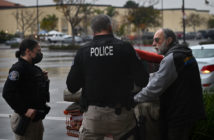Across the country, more and more police departments are turning to small body cameras to document day-to-day contacts with the public. Unlike cameras mounted in patrol cars, these actually travel with the officers wherever they go.
The devices are not perfect but from the video I have seen they do appear to be very effective. In a few cases, they have provided dramatic video of officer involved shootings.
Every police agency executive I recently have talked to isn’t just supportive but actively advocating for the use of body cameras. The reasons include a decrease in Use of Force incidents, reduction in complaints filed, and more cases being successfully prosecuted because of video evidence.
Even police unions support the use of body cameras. Anecdotal observations indicate video evidence is exonerating officers in the majority of complaints filed. Video evidence also significantly reduces the amount of time it takes to complete an internal affairs investigation.
In those cases where officers have violated policy and procedure, video evidence allows department executives to take the appropriate action to deal with the misconduct quickly and with confidence.
There are, however, significant privacy concerns as to how much of the video captured is a matter of public record. Let’s say you and the wife have a spat and officers are called out to referee. How public is the drunken, profanity-laden video now memorialized in cyberspace?
Of course, there are significant technology issues. Apparently a regular-size agency needs petabytes of storage to keep all the video collected. Even in day-to-day contacts, current public record law requires the archiving of video for a minimum of two years. This requires a lot of back-end support to keep the system functional and, of course, like everything else requires a lot of resources.
So what’s the hold up? Like so many things, it comes down to money. Most public agencies are still climbing out of a recession. A lot of the agencies I come in contact with are still trying to restore basic police services and bring their departments back to a point where they can deploy an adequate number of officers in the field and replenish depleted detective positions.
Agencies throughout the country would deploy body cameras immediately if they had the funding. What if the federal government took a lead on this? During the ’90s, there was a massive amount of support to the tune of $8.8 billion provided for community policing efforts. Billions are spent every year funding Homeland Security programs for local agencies throughout the country.
Congressional representatives need to take a serious look at providing grant funding for police agencies to purchase wearable camera devices. A good idea would be to start with those agencies struggling to establish trusting relationships with their communities.
When it comes down to it, body cameras are worth the return on investment when the end result is increased public trust. It’s time for our congressional representatives to take a leadership role in making body cameras a reality for departments across the country.
The police officers want it, and most importantly, the public will immediately benefit from it.
Below are some video links to police officers in action using body cameras:
Drunk driver who takes off after being stopped
Suspect armed with machetes is taken into custody
Joe is a retired Anaheim Police Department captain and its first public-information officer. He can be reached at jvargas@behindthebadgeoc.com
 Behind the Badge
Behind the Badge




